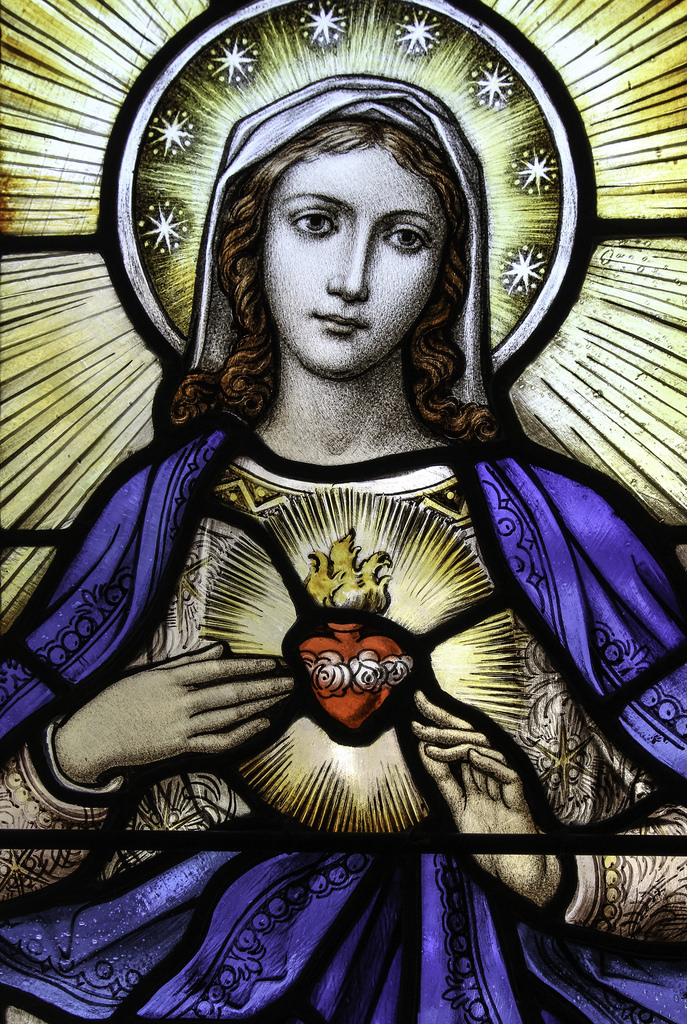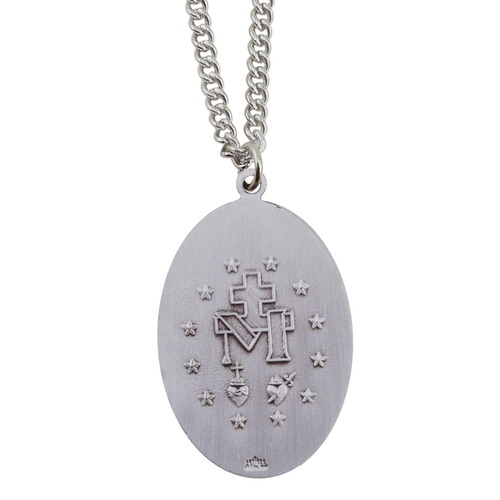A Consecration Prayer to Mary
We consecrate to thee our very being and our whole life; all that we have, all that we love, all that we are. To thee we give our bodies, our hearts and our souls; to thee we give our homes, our families, our country.
We desire that all that is in us and around us may belong to thee, and may share in the benefits of thy motherly benediction. And that this act of consecration may be truly efficacious and lasting, we renew this day at thy feet the promises of our Baptism and our first Holy Communion.
We pledge ourselves to profess courageously and at all times the truths of our holy Faith, and to live as befits Catholics who are duly submissive to all the directions of the Pope and the Bishops in communion with him.
We pledge ourselves to keep the commandments of God and His Church, in particular to keep holy the Lord's Day.
We likewise pledge ourselves to make the consoling practices of the Christian religion, and above all, Holy Communion, an integral part of our lives, in so far as we shall be able so to do.
Finally, we promise thee, O glorious Mother of God and loving Mother of men, to devote ourselves whole-heartedly to the service of thy blessed cult, in order to hasten and assure, through the sovereignty of thine Immaculate Heart, the coming of the kingdom of the Sacred Heart of thine adorable Son, in our own hearts and in those of all men, in our country and in all the world, as in heaven, so on earth. Amen.
Iconography and Tradition
One of the most popular Marian
devotions in the Catholic Church today is that of the Immaculate Heart of Mary,
often honored alongside the Sacred Heart of Jesus. This devotion has its roots
in Sacred Scripture, which makes frequent mention of Mary's contemplative
heart, for example in Luke 2:19:
"But Mary
treasured all these words and pondered them in her heart."
According to Catholic doctrine,
Mary is the Immaculate Conception; that is, in preparation for the Incarnation
of the Second Person of the Holy Trinity in her womb, Mary was conceived
without the corruption of original sin, and was preserved from committing any
actual sins throughout the course of her life through the infinite merits of
her Son, Jesus Christ. She was virginal not only of soul, but also of body,
both before and after giving birth to Our Lord. Our Lady was created literally
"Full of Grace" as the Archangel Gabriel declared at the
Annunciation, meaning that her soul was literally adorned with all of the
virtues at the moment of her conception, as well as all the gifts and fruits of
the Holy Spirit. This fullness of grace is said to emanate from the center of
her being—her heart—understood both physically and spiritually. It is Mary's
heart, in its unspoiled created perfection, that is the source and wellspring
of her purity . . . therefore her heart is called Immaculate.
Our Lord took His sacred humanity
from the flesh and blood of his Blessed Mother; Christ's heart is taken from
her heart. At Calvary, the perfect hearts of Jesus and Mary were united for the
salvation of mankind. And this is why the Two Hearts are honored together. While
the Sacred Heart of Jesus is the source of Christ's burning love for humanity,
and is largely spurned by the indifference of mankind towards Him, the
Immaculate Heart of Mary is the source of Our Lady's burning love for God and
her desire to bring souls to her Son, and is so often outraged by the offenses
of mankind committed against her love.
Over the centuries, as the saints
and theologians reflected on what it means for Our Lady to have pondered and
treasured the sacred events from the life of Jesus in her heart, as attested in
Scripture, Mary's heart began to be recognized as something to be imitated in
daily practice. Devotion to Mary's holy heart then developed, in much the same
way as it did for the Sacred Heart, which was physically pierced by the lance
on the Cross to give Eternal Life to men. So also does Mary's heart, which was
also pierced (as prophesied by Simeon) in union with her Son, give life—that
is, grace—to the Christian soul.
Beginning in the Middle Ages,
this devotion to Our Lady's purity of heart began to flower, culminating in St.
John Eudes actively promoting the devotion in the 17th century alongside that
of the Sacred Heart of Jesus. He also worked to have a feast established for
the Immaculate Heart of Mary, beginning in his native France.
After the 1830 apparition of the
Blessed Virgin Mary in Paris, which gave rise to the Miraculous Medal, efforts
were renewed to have devotion to the Immaculate Heart instituted as a feast for
the universal Church. In this Marian apparition, Our Lady showed St. Catherine
Laboure an image of a medal to be struck which would obtain many graces for
those who wore it faithfully, especially the grace of conversion for sinners.
On the front of the medal was an
image of Our Lady encircled with the words, O Mary, Conceived Without Sin, Pray
for Us Who Have Recourse to Thee, confirming the dogma of her Immaculate
Conception. One the reverse was an image of the Cross of Christ surmounted by
the letter "M", and underneath it the symbols of Sacred Heart of
Jesus and Immaculate Heart of Mary side-by-side, thus confirming the devotion
to her holy heart.
The spreading popularity of the Miraculous Medal soon gave rise to a Marian confraternity based on her Immaculate Heart and her power to convert sinners. The Notre-Dame-des-Victoires of the Archconfraternity of the Immaculate Heart of Mary, Refuge of Sinners was established in Paris in 1836 and quickly spread all over the world, with many graces, especially the conversion of sinners, obtained as a result. Then, in 1855, the feast of the Immaculate Heart of Mary (or Most Pure Heart of Mary) was approved by the Vatican, however, without establishing it for the universal Church.
Devotion to the Immaculate Heart
of Mary rose to a new level after the apparitions of Our Lady of Fatima. In her
visitations to Lucia, Jacinta, and Francisco, Our Lady revealed a vision of her
Immaculate Heart encircled with thorns which represented the many sins
committed against her. At Fatima, Our Lady asked for Russia to be consecrated
to her Immaculate Heart in order to prevent many calamities from occurring in
the Church and throughout the world.
Lucia describes the vision:
“As Our
Lady spoke these last words, she opened her hands and for the second time, she
communicated to us the rays of that same immense light. We saw ourselves in
this light, as it were, immersed in God. ... In front of the palm of Our Lady’s
right hand was a heart encircled by thorns which pierced it. We understood that
this was the Immaculate Heart of Mary, outraged by the sins of humanity, and
seeking reparation.”
At Fatima Our Lady also revealed
her request for the faithful to make Communions of Reparation to her Immaculate
Heart on five consecutive first Saturdays of the month. Therefore devotion to
the Immaculate Heart of Mary is closely associated with acts of reparation for
sins in order to obtain the salvation of sinners. When Sr. Lucia later asked
Our Lord why he would not convert Russia without having it consecrated to the
Immaculate Heart of Mary, Our Lord replied,
"Because
I want My whole Church to acknowledge that Consecration as a triumph of the
Immaculate Heart of Mary, so that it may extend its cult later on, and put the
Devotion to My Mother’s Immaculate Heart beside the Devotion to My Sacred
Heart."
After the apparitions of Our Lady of Fatima, the feast of the Immaculate Heart of Mary was instituted for the universal Church by Pope Pius XII in 1944. The feast was originally celebrated on August 22nd, the octave day of the Solemnity of the Assumption. It was later moved to the Saturday following the feast of the Sacred Heart, so that the Two Hearts would appear side-by-side, Friday and Saturday, on the liturgical calendar. August 22nd was then made the feast of the Queenship of the Blessed Virgin Mary, connecting the Assumption to her reign in heaven (the 4th and 5th Glorious Mysteries of the Holy Rosary).
Traditionally, the Church
encourages special devotion to the Immaculate Heart of Mary during the entire
month of August.
Reference
https://parishesontheprairie.org/feasts-of-the-sacred-immaculate-hearts/
https://www.catholiccompany.com/magazine/devotion-immaculate-heart-mary-6227




No comments:
Post a Comment